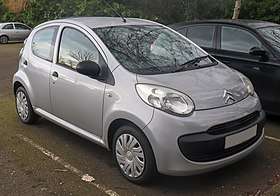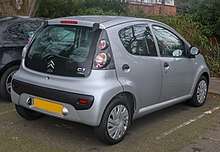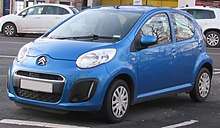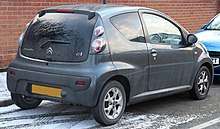Citroën C1
The Citroën C1 is a city car produced by the French manufacturer Citroën since June 2005.[1] The C1 was developed as part of the B-Zero project by PSA Peugeot Citroën, in a joint venture with Toyota.
| Citroën C1 | |
|---|---|
 The second generation Citroën C1 | |
| Overview | |
| Manufacturer | Citroën |
| Also called | Peugeot 107 (2005–2014) Peugeot 108 Toyota Aygo |
| Production | 2005–present |
| Assembly | Kolín, Czech Republic (TPCA) |
| Body and chassis | |
| Class | City car (A) |
The Peugeot 107 is identical to the C1, other than the front bumper and front and rear lights, while the Toyota Aygo is slightly more differentiated, but still obviously similar like its Asian made facelifted Yaris hatchback and sedan and facelifted third generation Vios.
All of them are built at the new facilities of the TPCA joint venture (Toyota Peugeot Citroën Automobile) in the city of Kolín, Czech Republic. The project was presented for the first time at the 2005 Geneva Motor Show. The cars are four seater, three door or five door hatchbacks measuring 3.40 metres (133.9 in) in length. The body was designed by Donato Coco.
First generation (2005–2014)
| First generation | |
|---|---|
 | |
| Overview | |
| Production | 2005–2014 |
| Assembly | Kolín, Czech Republic (TPCA) |
| Designer | Donato Coco |
| Body and chassis | |
| Body style | |
| Layout | Front-engine, front-wheel-drive |
| Powertrain | |
| Engine | |
| Transmission |
|
| Dimensions | |
| Wheelbase | 2,340 mm (92.1 in) |
| Length | 3,435 mm (135.2 in) |
| Width | 1,630 mm (64.2 in) |
| Height | 1,468 mm (57.8 in) |
| Curb weight | 1,775 lb (805 kg) |

On both the five door C1 and 107, though not the Aygo, the rear tail light cluster extends from the edge of the rear doors to the rear window, without a visually expressed "C-pillar".
The C1 is powered by a 1.0 L three cylinder engine, which has a fuel economy of 61.4 mpg (UK gallons EU method; 4.6 L/100 km EU method; ca 43.4 mpg US with US method). A 1.4 L four cylinder HDI diesel engine which has a fuel economy of 68.9 mpg (UK gallons EU method; 4.1 L/100 km EU method; ca 48.8 mpg US with US method) is also available.
According to the German magazine Der Spiegel, the C1 is the production car with the second-best fuel economy both among petrol engines (after the Toyota Prius)[2] and among diesel engines (after the Smart ForTwo).[3]
In January 2010, PSA Peugeot Citroën announced that it was recalling "under 100,000 units" of the C1 and the Peugeot 107, following the worldwide recall by Toyota for a faulty sticking accelerator pedal – which the Aygo is affected by. Under certain circumstances, the pedal can stick in a partially depressed position, or return slowly to the off position.[4]
Engines
| Model | Engine | Displacement | Power | Torque | 0–100 km/h (0–62 mph) |
Top speed | CO 2 emission (g/km) |
|---|---|---|---|---|---|---|---|
| 1.0i 12V | I3 | 998 cc | 68 PS (50 kW; 67 hp) at 6,000 rpm | 93 N⋅m (69 lbf⋅ft) at 3,600 rpm | 14.3 s | 158 km/h (98 mph) | 106 |
| Model | Engine | Displacement | Power | Torque | 0–100 km/h (0–62 mph) |
Top speed | CO 2 emission (g/km) |
|---|---|---|---|---|---|---|---|
| 1.4HDi 8V | I4 | 1398 cc | 55 PS (40 kW; 54 hp) at 4,000 rpm | 130 N⋅m (96 lbf⋅ft) at 1,750 rpm | 15.6 s | 140 km/h (90 mph) | 109 |
Trim range (United Kingdom)
- The Vibe, available in three-door or five-door, this was the basic model and the cheapest. Did not come with central locking, a rev counter or electric windows. Only available with the 1.0i engine.
- The Rhythm, available in three-door or five-door, this trim added remote central locking, colour-coded wing mirrors, two side airbags and an engine rev counter. The 1.4 HDi diesel and the 1.0i petrol engines were both available with this trim.
- The Code, available in three-door or five-door and with the 1.4 HDi engine, added to the Rhythm specification by including 14 inch alloy wheels, half leather-trimmed seats, chrome interior trim inserts and a glove box cover.
- Special editions (United Kingdom)
- The Cool – based on the Vibe, adding air conditioning and blue seat fabrics/dashboard inserts, available in Lipizan White or Damas Blue.
- The Airplay – based on the Rhythm, adding full iPod connectivity, iPod cradle, a 4 GB iPod Nano and coloured dashboard inserts and door pulls. Early models were available with bright, swirling decals. This model was originally revealed at the 2006 British International Motor Show in July 2006.
Designer Franco Sbarro created an extreme C1, called the C1 GT, a design concept that follows the same theme of his previous Xsara Picasso Concept. The extreme bodywork feature very wide wheels and gullwing doors, alongside a modified 1.6L 125 PS (92 kW; 123 hp) engine from the C2VTR and C4 WRC rallycar brakes. It is said to have reached over 130 mph (210 km/h).
In Portugal, a commercial van version called the Entreprise is offered, equipped with the 1.4L diesel engine and available only in the three-door body, for urban use. Its 107 sibling also offers an identical version.
In the United Kingdom, the Electric Car Corporation has been selling an electric car based on the C1, called the Citroën C1 ev'ie since 30 April 2009. Its list price on that date was £16,850 (US$24,989), "double the cost of the petrol version".[5][6][7]
2009 Facelift
_%E2%80%93_Frontansicht%2C_7._April_2011%2C_W%C3%BClfrath.jpg)
_%E2%80%93_Heckansicht%2C_7._April_2011%2C_W%C3%BClfrath.jpg)
In January 2009, the Citroën C1 was facelifted at the same time as the Peugeot 107 and Toyota Aygo.
The new C1 features a new front bumper incorporating a new grille, in keeping with Citroën's family look. Trim levels were also refreshed – basic Vibe models became 'VT', and Rhythm became 'VTR'. Seat fabrics and ventilation controls were also changed, and all models received colour-coded front bumpers and new wheel trims.
A special edition "Splash" was available at launch, though this was a strictly limited edition. This was based on the basic "VT". However, it featured air conditioning, a CD player and electric front windows. The Splash model was available in Electra Blue or Lipizan White. Electra Blue came with white door mirrors, whilst the Lipizan White came with glossy black door mirrors.
Engines remained the same, but tweaks mean the 1.0 petrol now emits just 106 g/km of CO
2 and reportedly able to achieve 72 mpg‑imp (3.9 L/100 km; 60 mpg‑US) fuel consumption. The 1.4 HDi diesel engine remains unchanged, again only available in the higher specification. Three new colours were also added to the line-up.
2012 Facelift


Citroën made a further facelift in March 2012. Changes included;
- New bumper
- New LED daytime running lights
- New shade of blue paint "Botticelli Blue"
- Improved fuel economy
- New style steering wheel
- Updated CD player
Two new trims were added to the facelift C1 range – Platinum and Edition, both coming with alloy wheels, leather steering wheel and gearstick as standard. VTR+ became the entry level when these were introduced.
Reliability
Breakdown statistics reported by the German Automobile Club in May 2010 placed the Citroën C1 (which the data grouped with the Peugeot 107 and Toyota Aygo) at the top of the sub small car class, in respect of the low breakdown rates achieved for cars aged between one and four years.[8][9] Class laggards were the Chevrolet Matiz (0–3-year-old cars) and the Smart Fortwo (4–5-year-old cars[8]).
Second generation (2014–present)
| Second generation | |
|---|---|
_%E2%80%93_Frontansicht%2C_19._September_2015%2C_Frankfurt.jpg) | |
| Overview | |
| Production | 2014–present |
| Assembly | Kolín, Czech Republic (TPCA) |
| Body and chassis | |
| Body style | |
| Layout | Front-engine, front-wheel-drive |
| Powertrain | |
| Engine | 1.0 L 1KR-FE I3 (petrol; KGB40) 1.2 L EB2 I3 (petrol; PAB40) |
| Dimensions | |
| Wheelbase | 2,340 mm (92.1 in) |
| Length | 3,470 mm (136.6 in) |
| Width | 1,620 mm (63.8 in) |
| Height | 1,468 mm (57.8 in) |
| Curb weight | 1,775 lb (805 kg) |
_%E2%80%93_Heckansicht%2C_19._September_2015%2C_Frankfurt.jpg)
At the 2014 Geneva Motor Show, Citroën revealed the new look, completely redesigned version of the C1, which is built at a factory of the Toyota Peugeot Citroën Automobile Czech (TPCA) in a joint venture between the Peugeot 108 and Toyota Aygo.
Sales
| Year | Worldwide production | Worldwide sales | Notes |
|---|---|---|---|
| 2009 | 116,100[11] | 117,000[11] | |
| 2010 | 102,250[11] | 105,200[11] | |
| 2011 | 88,669[1] | 87,673[1] | Total production reached 639,760 units.[1] |
| 2012 | 65,800[12] | 66,700[12] | Total production reached 705,600 units.[12] |
| 2013 | 58,470[13] | 59,500[13] | |
| 2014 | 64,650[14] | 62,500[14] | |
| 2015 | 60,630[14] | 62,100[14] |
See also
Citroën C1 ev'ie—an electric vehicle conversion of the C1
References
- "Memento March 2012" (PDF). PSA Peugeot Citroën. March 2013. Retrieved 1 May 2013.
- "Die sparsamsten Benziner (German)". Der Spiegel. 6 February 2007. Retrieved 28 November 2008.
- "Die sparsamsten Diesel (German)". Der Spiegel. 6 February 2007. Retrieved 28 November 2008.
- "Peugeot follows Toyota in Car Recall". BBC News. 30 January 2010. Retrieved 2 June 2011.
- Webster, Ben (30 April 2009), "Electric Citroën C1 car is ready, but government grants are not", The Times, London, retrieved 1 May 2013
- "Car Reviews – First Drive", Autocar, 30 April 2009, retrieved 1 May 2013
- "The Electric Car Corporation Launches the Citroën C1 ev'ie – The UK's First 4 Seat All-Electric Production Car", theautochannel.com, 30 April 2009, retrieved 1 May 2013
- Rudschies, Wolfgang; Dieckmann, Hendrik; Kroher, Thomas (2010). Ramstetter, Michael (ed.). "Die ADAC Pannenstatistik 2009". ADAC Motorwelt (May): 26–27.
- "Pannenstatistik – Kleinstwagen", ADAC Motorwelt, May 2010, retrieved 13 May 2010
- "Euro NCAP results for Citroën C1 1.0 5 door LHD hatchback". euroncap.com. 2005.
- "PSA Peugeot Citroën 2010 Registration Document" (PDF). PSA Peugeot Citroën. 22 April 2011. Archived from the original (PDF) on 5 June 2017. Retrieved 29 November 2012.
- "Memento Mars 2013" (in French). PSA Peugeot Citroën. 21 February 2013: 50. Retrieved 31 July 2013. Cite journal requires
|journal=(help) - "PSA Group Annual Report 2014". PSA Peugeot Citroën. 20 February 2015. Retrieved 22 December 2016.
- "PSA Group Annual Report 2015". PSA Peugeot Citroën. 24 February 2016. Retrieved 22 December 2016.